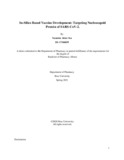| dc.contributor.advisor | Siam, Mohammad Kawsar Sharif | |
| dc.contributor.author | Iva, Yesmine Akter | |
| dc.date.accessioned | 2022-07-25T07:17:40Z | |
| dc.date.available | 2022-07-25T07:17:40Z | |
| dc.date.copyright | 2021 | |
| dc.date.issued | 2021 | |
| dc.identifier.other | ID 17346029 | |
| dc.identifier.uri | http://hdl.handle.net/10361/17040 | |
| dc.description | This thesis is submitted in partial fulfillment of the requirements for the degree of Bachelor of Pharmacy, 2021. | en_US |
| dc.description | Cataloged from PDF version of thesis report. | |
| dc.description | Includes bibliographical references (pages 57-61). | |
| dc.description.abstract | SARS-CoV-2 is a highly contagious and virulent coronavirus that has triggered a pandemic of acute respiratory disease (COVID-19), endangering human health. In this study the goal was to develop a peptide based multi-epitope sub-unit vaccine against SARS-Cov-2 that would utilize the Nucleocapsid protein (N). Antigen was selected based on two primary criteria: (1) Protein antigenicity. (2) Protein Functionality. At first the structural Nucleocapsid protein (N) was selected through proteomic screening for analysis by using Vipr database. Then Vaxijen 2.0 was used to test the antigenicity of our proteins at a minimal threshold of 0.5. This study used immunoinformatics approaches to discover B cell and T cell epitopes for SARS-CoV-2 Nucleocapsid protein (N), then estimated their antigenicity and corresponding relationships with human leukocyte antigen (HLA) alleles. All of the identified epitopes were then linked to the core antigen using the appropriate linkers to develop the vaccine formulation. Antigenicity of this developed vaccine was 0.5135. 11 B cell epitopes, 9 MHC class-I and 2 MHC class-II strong binding of Tcells epitopes were identified. Analyses of allergenicity, toxicity, and physicochemical properties confirmed the epitopes' specificity and selectivity. A PDB model of the final vaccine was created utilizing phyre2 server via homology modeling. From the biochemical analysis of PROTPARAM this research found that the vaccine and crude N protein had an aliphatic index of 48.47 and 52.53 respectively, while the unstability indexes are at 60.89 and 55.81 accordingly. Again, the vaccine construct's and crude N protein's Grand Average of Hydropathicity (GRAVY) values are -1.110 and -0.980 respectively. Then from Patchdock the best complex score of 18094 in the molecular docking algorithm based on shape complementarity principles under the area of 2671.30 square angstrom in the Atomic Contact Energy (ACE) of 464.89 was selected. An in-silico simulation study was conducted utilizing the C-immsim server to further verify the credibility of this vaccine's effectiveness, and as the result was unstable so addition of chaperones can help to stabilize the vaccine. | en_US |
| dc.description.statementofresponsibility | Yesmine Akter Iva | |
| dc.format.extent | 61 pages | |
| dc.language.iso | en | en_US |
| dc.publisher | Brac University | en_US |
| dc.rights | Brac University theses are protected by copyright. They may be viewed from this source for any purpose, but reproduction or distribution in any format is prohibited without written permission. | |
| dc.subject | SARS-CoV-2 | en_US |
| dc.subject | Nucleocapsid protein | en_US |
| dc.subject | Vaccine | en_US |
| dc.subject.lcsh | COVID-19 (Disease) | |
| dc.title | In-silico based vaccine development: targeting nucleocapsid protein of SARS-CoV-2. | en_US |
| dc.type | Thesis | en_US |
| dc.contributor.department | Department of Pharmacy, Brac University | |
| dc.description.degree | B. Pharmacy | |

